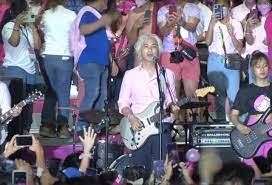 Three years ago, I posted a Twitter thread on political music in our history, from the revolution to recent times. As we wait for tonight’s Miting de Avance, it would do well to do a thread on 2021-22’s epic political music experience. By the way I turned my thread on political music into a podcast, too. But now let’s go on to the songs that made 2021-22 in terms of political music. This has been the most musically-diverse and creative campaign yet.
Three years ago, I posted a Twitter thread on political music in our history, from the revolution to recent times. As we wait for tonight’s Miting de Avance, it would do well to do a thread on 2021-22’s epic political music experience. By the way I turned my thread on political music into a podcast, too. But now let’s go on to the songs that made 2021-22 in terms of political music. This has been the most musically-diverse and creative campaign yet.
There is the anti-dictatorship era DNA, musically, of the campaign harkening back not only to 1983-86 but even earlier to the 1970 FQS and radical street theater. Both encapsulated here:
The act of taking a song imprinted with the memories and meaning of a past era, and using it to help inspire a new one, is the musical equivalent of handing the torch from one generation to the next.
There is, too, the continuation of the words and symbols of past resistance: Laban, Fight! With the added bonus of alliteration –Laban, Leni.
There should be a special place for “Kay Leni Tayo,” a song born under a particular set of circumstances, when it was unknown if Leni would run: so, to prove to her and to everyone, she should run, because she would get support.
It was a particular point in time when the political pros were uncertain; and, as in earlier times, it was much a time for mounting a popular draft, as it was a time for standing up to inspire others to take a stand for her candidacy and what it would represent. It was versatile.
But if it could be poignant it was was first and foremost imbued with the spirit that has come to characterize the campaign: diverse, fun, and joyful. It inspired individually and moved collectively.
And it could move forward and backward in time, harnessing rhythms from our deepest past, embracing the rhythms of earlier times that can still quicken the pulse and impress the crowd.
“Kay Leni Tayo” was –is– a song of movement –for a movement. And again the rhythmic drums and beats that had been the percussive background to generations of rallies beat again to a new song.
But so big were the feelings –and so big was the movement– awakened, that no single song or tune could encompass the multitudes. Another song has come to define the romantic side of the big feelings awakened: “Rosas.”
If the movement’s had a diversity of members so too have the musicians inspired to contribute their talents been diverse: with all genres, it seems, finding a comfortable welcoming place : from classical to jazz to pop to hard metal, from dancing to singing and mixing.
Community singing: public singing, at the drop of a hat; the flashmob approach, too, was seen.
The parties and movements of the past may have faded, but there are new ways to organize, new affiliations, new categorizations. New languages, even, to express and participate and join, new art forms, and the ways they can combine.
There, too, is “call-and-response,” the rhythm of cooperation, of collective identification. The energy-giving give-and-take. Ideally suited to the remixing and repurposing that preserves individuality even in collectives.
For that’s the current clime and times too: the mashup, the remix, the visual flair added to turn an earworm into a mantra to accompany you into the fight…
And there, too, in this thread of big feelings, the imagery that motivates, that literally enlightens. “Liwanag sa Dilim” evokes faith, fortitude, hope and deliverance. It is as much heir of the Katipunan as it is of Gospel ideals.
It is an epic song for an epic time that calls for an epic choice –where those who can lose something, are asked to risk something. Particularly since done without pay, artists standing up means artists taking a risk.
The result, as the past taught us but which every generation has to be taught again, is that if cowardice is contagious, courage can be even more so. Breathtakingly and repeatedly so.
And as the torch is passed, more and more ways are found to have yesterday contribute to today as a contribution for a better tomorrow. Meanings are rediscovered, and added to. Genres stand up to be represented.
There are so many big feels the songs are just bursting out to be written and performed.
The cross-fertilization, art inspiring art, creativity resulting in even more creativity, continues.
Which leads me to close with the music of He-Who-Shall-Not-Be-Named. How sad, grey, monotonous, and sterile it is, to rely on only one song, a song imbued with its own big feelings, so many of them of rejection and pain. But that was the dream they want to revive: of uniformity.
Then, as now, in every generation, as the elder Diokno once told us and the younger Diokno is campaigning to remind us, all we want is to be able to sing our own song –without being forced to sing someone else’s.